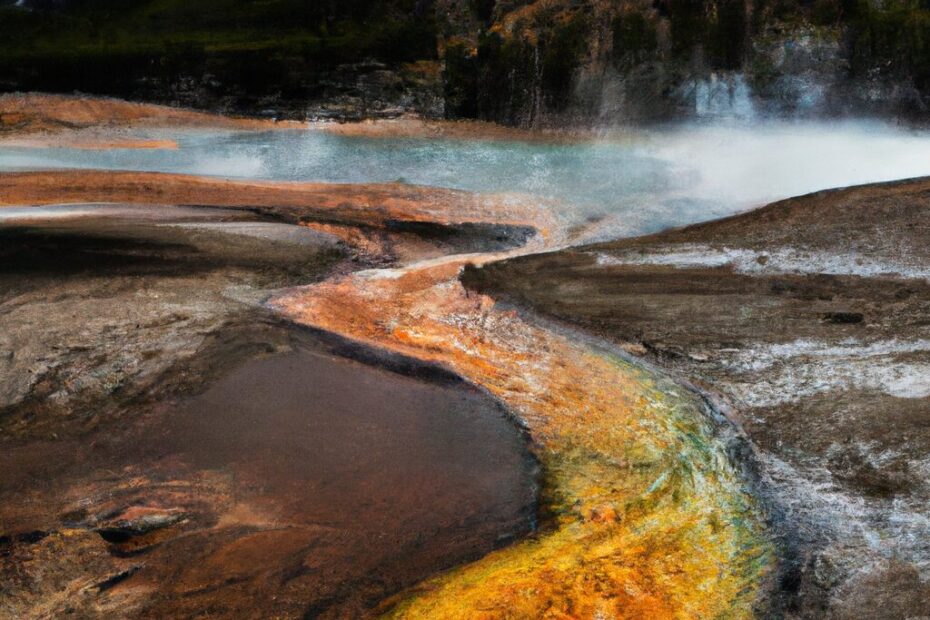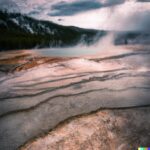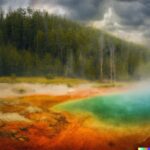Yellowstone National Park is famous for its spectacular geysers, but have you ever wondered what causes these natural wonders to erupt?
In this article, we will explore the fascinating world of geysers, including their location in Yellowstone, the factors that trigger their eruptions, and the different types of geysers found in the park.
We will also delve into the unique yellow color of Yellowstone’s geysers and the effects of human activity on these natural marvels.
So, grab a cup of coffee, sit back, and let’s dive into the captivating world of Yellowstone geysers.
What Are Geysers?
Geysers are hydrothermal features that showcase the immense thermal energy and underground reservoirs present in volcanic areas such as Yellowstone National Park.
Geysers are formed by a combination of underground water, heat from magma chambers, and narrow passages that allow water to escape as steam. This process results in the dramatic eruptions that geysers are famous for.
The presence of geysers is a sign of rich geothermal activity in the area, providing valuable insights into the Earth’s internal processes. Yellowstone National Park, home to more than half of the world’s geysers, is a prime example of this captivating geothermal phenomenon.
Where Are Yellowstone Geysers Located?
Yellowstone geysers are prominently located within the geothermal activity of the park, demonstrating their association with geologic hotspots and underground geothermal reservoirs.
In this unique ecosystem, the geysers are concentrated in specific locations such as the Upper Geyser Basin, known for its iconic Old Faithful. The park’s geothermal activity is connected to the underlying volcanic processes, which create a conducive environment for the formation of these natural wonders.
The presence of underground reservoirs of heated water and the interaction with the magma chamber beneath the Earth’s surface contribute to the periodic eruptions and spectacular displays that make Yellowstone’s geysers a truly remarkable sight.
What Causes Geysers to Erupt?
The eruption of geysers results from a complex interplay of volcanic activity, heat, pressure, and water, driven by geological processes and interconnected with hot springs.
What Is the Role of Heat in Geyser Eruptions?
Heat is a crucial factor in geyser eruptions, influenced by the geothermal gradient and the presence of geothermal reservoirs in the park’s unique geologic environment.
The abundance of thermal features in Yellowstone highlights the intricate interplay between heat, water, and underground geological formations.
The geothermal gradient, which increases in temperature with depth, is the driving force behind the intense geological activities that fuel the powerful eruptions seen in the park’s iconic geysers. The geothermal reservoirs, which hold large amounts of superheated water and steam, add to the spectacle and contribute to the magnificence and unpredictability of these natural phenomena.
What Is the Role of Water in Geyser Eruptions?
Water serves as a critical component in geyser eruptions, interacting within the park’s hydrothermal system and within the intricate network of geologic formations and subterranean activity.
The significance of geysers lies in their interaction with superheated rock and minerals beneath the Earth’s surface. This creates the pressure necessary for the explosive release of steam and hot water.
The water’s journey through porous and fractured rock formations is crucial to the periodic eruptions of geysers. As it becomes heated and pressurized, it leads to the spectacular displays witnessed by visitors. Studying the complex dynamics of water in geyser eruptions offers valuable insights into the fascinating geological processes at work in these natural wonders.
What Is the Role of Pressure in Geyser Eruptions?
Pressure exerts a significant influence on geyser eruptions, involving the build-up of steam within the park’s intricate network of geologic faults and diverse geologic settings.
Geological fault lines and diverse settings create a pressurized environment when combined with the weight of overlying rocks and water. This pressure causes water at depth to reach boiling point, forming steam. The accumulated steam then searches for weak spots in the surface, resulting in explosive eruptions that propel water and steam into the air.
The mesmerizing spectacle of geyser eruptions is a unique combination of pressure, water, and geologic conditions, playing out in nature’s theater.
What Other Factors Contribute to Geyser Eruptions?
Various other factors contribute to geyser eruptions, including the park’s rich geologic processes, historical context, and seismological activity, shaping the dynamics of these remarkable natural phenomena.
The geologic processes play a pivotal role as the unique combination of underground thermal features and volcanic activity create the ideal conditions for geyser formation.
Historical significance adds another layer to the understanding of these eruptions, as the documentation of past events helps in predicting future occurrences. Seismological activity, such as earthquakes and tectonic movements, directly impacts the hydrothermal system, influencing the behavior of geysers.
Understanding these factors provides a holistic view of how the park’s natural attributes influence these awe-inspiring eruptions.
What Are the Different Types of Geysers?
Yellowstone is home to various types of geysers, including fountain geysers, cone geysers, and unique fountain-cone geysers, each exhibiting distinct characteristics and eruption patterns.
Fountain geysers, such as the iconic Old Faithful, erupt with a burst of water and steam, reaching impressive heights and following a predictable schedule.
Cone geysers, like Castle Geyser, erupt from a cone-shaped vent and often have more irregular eruption patterns.
The hybrid fountain-cone geysers, like Great Fountain Geyser, combine features of both fountain and cone geysers, with eruptions that exhibit elements of both types.
These diverse geysers create a mesmerizing display of natural phenomena in Yellowstone.
What Are Fountain Geysers?
Fountain geysers in Yellowstone exhibit distinctive eruption behavior, influenced by specific geologic determinants that contribute to their captivating and unique display of thermal activity.
These geysers are intricately linked to the underlying hydrothermal systems, which are influenced by the presence of fractures and faults in the Earth’s crust. As a result, the eruption patterns of fountain geysers are dynamic, with intermittent bursts of boiling water and steam shooting up into the air.
The interaction between the superheated water and the unique geologic features creates a mesmerizing spectacle that draws visitors from around the world to witness nature’s powerful forces at play.
What Are Cone Geysers?
Cone geysers found in Yellowstone are defined by their specific geologic settings, influencing their geyser activity and contributing to the formation of their characteristic cone-shaped structures.
Geysers are commonly found in volcanic areas, where underground molten rock heats water, causing it to erupt in periodic jets. The cone structure around the geyser’s vent is formed by mineral deposits left behind from these eruptions. This unique geological process gives cone geysers their distinct appearance, setting them apart from other geothermal features in volcanic regions.
What Are Fountain-Cone Geysers?
The unique fountain-cone geysers in Yellowstone are shaped by specific geothermal causes, resulting in mesmerizing geyser patterns and showcasing the interplay of distinct geological forces.
Geysers are known for their impressive vertical eruptions, with water shooting up from the center of a cone, creating a captivating spectacle. This formation process occurs when underground water encounters hot rock, leading to steam build-up and eventual release through the narrow opening of the cone.
The resulting eruption patterns vary in height and duration, adding to the allure of these natural wonders. This connection between geothermal activity and geyser patterns is a remarkable example of the Earth’s fascinating processes at play.
Why Are Yellowstone Geysers Yellow?
The yellow color of Yellowstone geysers is attributed to the presence of specific mineral deposits, contributing to the unique visual spectacle and distinctive appearance of these natural wonders.
The geysers in Yellowstone National Park are known for their breathtaking colors, thanks to mineral deposits like sulfur. These deposits create stunning shades of yellow, gold, and ochre that give the geysers a mesmerizing glow. As hot water interacts with these minerals, intricate patterns form and add to the enchanting allure of these geothermal features.
Visitors from around the world are captivated by the vibrant colors that stand out against the earthy surroundings. The result is a truly unforgettable sight that showcases the unique beauty of Yellowstone’s geysers.
What Causes the Yellow Color of the Water?
The yellow color of the water in Yellowstone geysers stems from the interaction with thermal springs and the manifestation of unique geothermal phenomena, contributing to the vibrant and captivating visual display.
This captivating phenomenon occurs due to the presence of sulfur deposits in the surrounding rock formations. As the water percolates through these deposits, it dissolves trace amounts of sulfur compounds, imparting the distinct yellow hue to the geyser water.
The high temperature and minerals in the water create an ideal environment for microbial thermophiles, which also contribute to the coloration through their biological pigments. These combined factors result in the enchanting and otherworldly appearance of the geysers throughout the park.
What Are the Minerals Present in Yellowstone Geysers?
Yellowstone geysers host a diverse array of minerals, sourced from hydrothermal vents and shaped by intricate geologic processes, contributing to the rich diversity and unique composition of these thermal features.
Yellowstone National Park is home to a variety of minerals, including silica and calcium carbonate. These minerals form unique structures like sinter terraces and colorful formations known as travertine.
The presence of iron oxides also adds to the stunning landscapes of the park. These minerals come from hydrothermal fluids beneath the surface, which interact with the environment to create the visually captivating features that make Yellowstone a geological wonder.
What Are the Effects of Human Activity on Yellowstone Geysers?
Human activity has the potential to impact Yellowstone geysers, influencing geological formations and interacting with the park’s tectonic movements, which necessitates careful consideration and conservation efforts.
Such influences can manifest in various ways, such as altering the flow and periodicity of the geysers, or even causing changes in the underlying geological structures.
The extraction of geothermal energy, for instance, can lead to fluctuations in the subterranean water pressure, potentially affecting the hydrothermal features.
Human infrastructure and disturbances can disrupt the delicate balance of the park’s tectonic landscape, necessitating a balance between resource utilization and environmental preservation.
How Has Human Activity Affected Geyser Eruptions?
Human activity has influenced geyser eruptions by interacting with geologic faults and altering specific geologic conditions, necessitating a thorough understanding and proactive measures to mitigate potential impacts.
This influence is exemplified in cases where human-induced changes in hydrothermal systems, such as altering the water pressure or flow rate, have led to modifications in geyser behavior.
Anthropogenic activities can introduce foreign substances into these systems, affecting the delicate balance of mineral deposits and underground water dynamics, consequently influencing geyser eruptions.
The alteration of geologic conditions can disrupt the natural processes that regulate geyser activity, affecting their frequency and intensity.
Understanding these interactions is crucial for ensuring prudent and sustainable management of geothermal areas.
What Steps Are Being Taken to Protect Yellowstone Geysers?
Efforts are underway to safeguard Yellowstone geysers through comprehensive conservation measures, aimed at preserving the park’s unique geothermal environment and ensuring the longevity of these captivating natural wonders.
In order to preserve the delicate balance of geysers, strict regulations have been put in place to prevent human interference. These regulations include maintaining safe distances from the geysers. Additionally, ongoing educational programs and visitor guidelines play a crucial role in increasing awareness about the fragility of these geothermal features and promoting responsible tourism.
Advanced monitoring technologies are also utilized to track changes in geyser behavior, allowing for swift responses to any potential threats. This multi-faceted approach demonstrates a commitment to preserving Yellowstone’s geysers, finding a balance between conservation and sustainable enjoyment for future generations.
Frequently Asked Questions
What causes Yellowstone geysers to erupt?
Yellowstone geysers erupt due to a combination of hot water, underground plumbing, and steam buildup.
Do all geysers in Yellowstone erupt?
No, not all geysers in Yellowstone erupt. Some only erupt once every few years or even decades.
Why is Yellowstone National Park known for its geysers?
Yellowstone is known for its geysers because it sits on top of a supervolcano with an active magma chamber, creating the perfect conditions for geothermal activity.
What factors contribute to the formation of geysers in Yellowstone?
The presence of a heat source, a water source, and a subsurface reservoir are all necessary for the formation of geysers in Yellowstone.
Can human activity affect the geysers in Yellowstone?
Yes, human activity such as drilling, pollution, and water diversion can potentially impact the geysers in Yellowstone by altering the delicate balance of temperature and pressure in the geothermal system.
Are there any ongoing studies to better understand the causes of Yellowstone geysers?
Yes, there are ongoing studies and research being conducted in Yellowstone National Park to better understand the complex processes that cause geysers to erupt.
Last Updated on January 25, 2024 by Jon Waraas – Originally Posted: January 25, 2024

I’m Jon Waraas, and I’ve been navigating the online world since 2006. By day, I’m the proud owner of some eCommerce gems, and by night, I’m the voice behind the adventures on Waraas.Com.
My heart, however, belongs to the wild beauty of Yellowstone National Park. I’ve got a collection of websites dedicated to sharing the wonders of this natural masterpiece. Oh, and did I mention? I’m currently building my own cabin inside the ghost town of Gilmore, Idaho – a cabin with tales to tell!
When I’m not immersed in the digital realm, you’ll find me lacing up my boots for a good hike or setting up camp under the star-studded sky.




